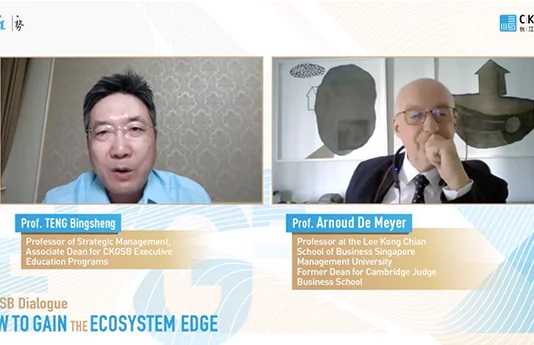Marketing is an important function at any time, but it’s perhaps most crucial for a company entering a hypergrowth phase. The product might be selling well, but can be killed by any number of missteps: create demand faster than you can fill orders, and the market may turn away from your brand, never to return. Move too slowly and a competitor may elbow you aside. Target the wrong market and in two years, your product may be obsolete and unable to meet the needs of the emerging market.
Experts say that it’s not easy to get it right, but with careful management, it is possible for executives to dodge some of the most common mistakes.
The most common problem is a lack of a strategic plan, according to Joseph Lassiter, Senator John Heinz Professor of Management Practice in Environmental Management at Harvard Business School. “Nobody has a plan and so every day in the company, you draw the play in the dirt and run, and you keep wondering why you don’t get where you want to go. The usual problem is not that the competitor beats you, it’s that you don’t have a goal in mind… you kind of squiggle off to the side of the road.”
One way in which companies lose their way, ironically, is in strong sales. “The opiate of the order and the money that comes from the orders and the drive to satisfy the customer just overwhelms your ability to manage the situation,” he says. Strategically, the problem is that it can stop the company from developing in the way it needs to if it is going to reach the broader market and stay competitive down the line.
Marketing theorist Geoffrey Moore (See ‘Helping Companies Cross the Chasm’) famously describes this challenge as “crossing the chasm”–making the jump from marketing for early adopters, who have a particular set of requirements, to reaching the larger market, which typically wants a somewhat different product.
Chinese companies face an additional marketing chasm too, according to Ben Cavender, Associate Principal of the China Market Research Group. Often, they need to get away from the price-based competition that they used to gain market share to competition based on quality.
At the other extreme, but just as fatal, is maintaining a view of the future even when it keeps bumping up against an inconvenient reality. “In the end, companies that do well react to the world as it is, and particularly in smaller companies, you really don’t have the choice to wait for the world to see your truth as truth,” Lassiter says.
Making the situation still more difficult is the fact that at precisely this moment, the founder is often shown the door and replaced by someone the board believes better suited to handling the marketing challenge of fast growth.
In a 10-year study in which he interviewed more than 10,000 business founders in technology and the life sciences, Noam Wasserman, Associate Professor of Business Administration at Harvard Business School, found that more than 50% of founders are replaced by an external CEO by the third round of financing.
“A lot of times fast growth is sparked by your bringing on rocket fuel from investors, outside parties who, as they are investing, take board seats so they can make sure that they are able to monitor their investment,” says Wasserman. “Often, at the same time, the demands on the CEO are going from a technical or a scientific need where it’s developing the product to functions that you’ve probably never worked in and that you aren’t familiar with.”
The company has to be showing great promise to survive to a third round, but ironically, that very promise frequently leads investors to send the founder packing. “At the same time as the company’s growth is starting to outstrip your capabilities, the people on the board have a very different read on whether you, as the founding CEO, should continue leading it, not only despite the fact that you have been succeeding smashingly until now, but almost because of that success that you’ve had,” Wasserman says.
For the founder, it’s a frustrating situation. In his book The Founder’s Dilemma, Wasserman sums up the dilemma by saying, “If the company tanks, I’m gone. But if it’s a big hit, I’m also gone. If I want to remain CEO, should I only aim for middling success?”
Common as it is, most companies aren’t prepared for the event. Replacement at this fast-growth stage tends to end traumatically: 73% of those who are replaced have to be fired, according to Wasserman’s data. But even those CEOs who say they are prepared for a shift in control and intend to stay on tend to find the shift wrenching. As one executive told Wasserman, the CEO tends to be prepared for a title change, “not a tidal change”.
Merrill R. Chapman, in his book In Search of Stupidity: Over 20 Years of High-Tech Marketing Disasters, is blunter: he argues that many companies, particularly tech companies, kill themselves through self-inflicted wounds suffered after spectacular initial success.
The New York-based software analyst sounds a bit facetious, but he makes a good case. Often, Chapman writes, it’s not Tom Peters-style excellence that wins in technology but simply competence. His irreverent look back at the growth of the US software industry in the 1980s and 1990s notes that nine of the top 10 software firms in 1984 had disappeared by 2001, and that all of them flopped because they did something stupid. Microsoft alone survived–and took 69% of the entire software market–less because of Bill Gates’ genius than because it didn’t bungle anything important.
Chapman recounts for instance the example of a wrong turn by an early leader in the word processing market, MicroPro, maker of WordStar, which went out of business in part because it created two products with the same price point, functionality, and target audience and tried to sell both at the same time. A few years later, Borland did the same thing, he said, followed by Novell.
Chapman has two sociological theories about why software companies make so many mistakes and seem to repeat them so often. His first is that it’s the result of the enthusiasm many in the tech industry had for est and its imitators, popular personal development programs of the 1970s and 1980s that suggested that your own feelings, beliefs, and experiences were all that mattered. This group, he says, “created large cadres of sociopaths who felt they were immune from such interpersonal obligations as saying they were sorry when they misbehaved”. All this effort “tending to your own reality” leads to less time worrying about others’ realities, he writes, “particularly unsuccessful ones, since your reality will obviously not include their failures”,
His second theory focuses on the nature of engineers and programmers who are happiest when they have complete control over their work environment, leading to a tendency to reject anything “not invented here” –a sort of Captain Nemo approach to technology development tends to drag companies under fairly frequently.
But it’s not only the big and stupid move that can be fatal. Sometimes, even overlooking a small detail can have serious consequences. For instance, management guru Peter Drucker once wrote about a client which failed in its joint venture in the Japanese market because the company never made clear who was to inform the purchasing agents that the partner defined its specifications in meters and kilograms rather than feet and pounds–and nobody ever did relay that information.”
Handling the marketing challenge isn’t easy, according to Lassiter.
First, “you have to have a belief about the pattern of adoption and you organize the company around the pattern of adoption and you then essentially react to that and modify your path as the company evolves,” Lassiter says.
“In small companies, the big thing you have to do if you’re growing rapidly, or more importantly, if you want to grow rapidly, is you have to have a strong feeling about the likely pattern of customer adoption–who is going to buy first and why are they going to buy it,” Lassiter says. At the same time, you need to think about who the dominant customer is likely to be in three years.
Getting that right might sound like an easy but impossible task, like looking in tomorrow’s newspaper for the closing prices of today’s stock market.
However, it can be done, Lassiter insists. The secret, he says, is not to think directly about how to get to your destination. “Oddly enough, the way you work your way through that road map–and this is going to be counterintuitive–is, you do that in reverse.”
Just as a children’s maze is much easier worked from the inside out, there are fewer paths moving from reverse going forward, according to Lassiter. “You need to be able to answer, how am I going to have to modify the product in year three, year two, one, zero? Who will I need as partners? Where can I find them?” he says.
Small companies, in particular, tend to have a hard time defining their product in the market. Typically, the task is to fit your product to the needs of a pre-existing category. “In little companies, typically you’re living with a bunch of conceptions and placing your product in a set of those conceptions,” he says.
Cavender says that making the shift from competing over price to competing over quality is not easy.
“I think the first step for brands is really emphasizing design. Start to invest in R&D, hire good designers, come out with very attractive signature products,” Cavender says.
Companies also need to focus on their service and their outlets. “It’s not just the ad copy,” Cavender says. In retail, for instance, Chinese companies tend not to have good training programs in place for store staff or good standardized plans for developing stores. Location-picking is not yet a science either.
Nor is the need for quality limited to the look of the shop. Overall efficiency is important. Having a good inventory system in place, for instance, helps creates the kind of trust customers need to feel the brand is reliable, according to Cavender.
Training programs to standardize service are crucial as well, but not easy in a market where many workers change jobs frequently. “It’s a struggle because it’s expensive to do that. There’s a lot of turnover in the retail space,” he says.
For Chapman, it all comes down to steady, careful steering. “One of stupidity’s most endearing traits is its egalitarian nature. Its eternal dull lamp beckons endlessly to those dim bulbs who seek to rip open the hulls of successful companies and ideas on the sharp rocks of bad judgment and ignorance. With stupidity, your reach never exceeds your grasp; any company, no matter how large or small, can aspire to commit acts of skull-numbing idiocy and have a hope of success.”
(Image courtesy: “Marketing Concept On Blackboard” by KROMKRATHOG www.freedigitalphotos.net)




















